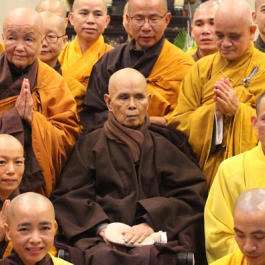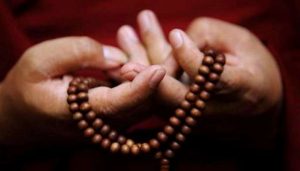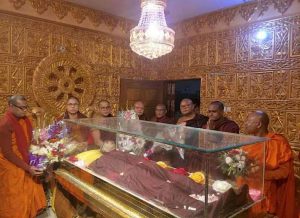During the pandemic, Dakini’s Whisper lineage holder and teacher Chöying Khandro set to work on writing Dakini Journey in the Contemporary World, which has had two volumes completed so far. Volume Two, The Heart of Chö, outlines her most profound teachings on the Buddhist feminine: the intensely personal yet universal encounter with Dakini as “a paradox of reality” that embodies “emptiness in action” (34), but also with the Five Elemental Dakinis that embody Buddha Nature itself, while Dakini is the Great Mother, Prajnaparamita.
Through 400 pages of a completely unique book, Chöying Khandro has set out to explain the many manifestations and meanings of Dakini. Yet her volume does more: it summarizes her teachings in a profound way. It certainly presents a feminine theme, although it is absolutely relevant to men. It goes far beyond feminism: it affirms women in the ultimate level, which is genderless. It unapologetically affirms, while qualitatively transcending.
“I like to say that the essence of Dakini is like chocolate,” she said. “How can you capture the taste of this delicious food without tasting it for yourself?” There is certainly an embodied, sensuous dimension to Dakini, in the sense that she is fully embodied and encompasses the physicality of the human body—after all, every individual meeting with Dakini is unique, depending on each of our inclinations, karma, and baggage. “I find that the Vajrayana concept of Dakini has become too mystified, and my book’s underlying theme is to inspire people with an accessible expression of Dakini. Dakini is absolutely accessible, although her profundity makes her ambiguous.”
What does Dakini look like to different people? What about her scent? What about her voice? Her touch? The essence of Dakini is none other than who or what we truly are, said Khandro-la. We all can access her, regardless of religious affiliation, social background, or any other personal context. Khandro-la wished to stress that Dakini’s essence is not only in her, but also in everyone. It is not something reserved for elite masters.
One of her most important paragraphs in this book is about how she defines the “dakini journey”—an odyssey, a pilgrimage, to attain insight, but without spiritual bypassing. It is one that embraces the full person:
“The Dakini Journey has been an invitation to live and dance our own Dakini dance with compassion and emptiness—two sides of the same coin. It’s an invitation to discover our own compassionate, colorful dance as Dakini within the boundless expanse of sky. We have seen this beautiful and harmonious union in Dakini, the dancer of paradox. As our Dakini eyes have opened, it may feel like our journey, as Dakini in the world of joy and sorrow, passion, and horror, has just begun. But having felt the awakened qualities of Dakini such as softness, tenderness, richness, spontaneity, courage, confidence, fearlessness, and ferocity within, we are now ready to integrate, embody, express, and celebrate Dakini in the world. It’s time to fully show our Dakini selves to the world!”
(376–77)
The full person, to avoid spiritual bypassing, must encounter the Dakini on her own terms. This means entering the charnel ground, which the early tantric Buddhists in their wisdom identified as the mythic location that represents vulnerability, our shadow, the side that we do not want to see. (138) Khandro-la said: “Vulnerability is what connects us to human beings. When we express something fragile about ourselves, we enter the charnel ground. This is a very precious experience. It’s the place where we meet Dakini. We can’t meet her in a normal, comfortable place. We must enter her abode.” And, of course, Dakini can manifest fiercely, but she always comes from a place of compassion.
The charnel ground has several dimensions: the literal place as described by tantric masters, our shadow which consists of insecurities, fears, and bad memories, and finally the deeply embedded and conditioned subtle grasping that betrays our samsaric condition. This was particularly resonant with men, as male vulnerability has often been hidden away, shamed, or ignored in modern society. Men in particular are conditioned to be fearful of not only surrendering their attachments—accumulations, wealth, status, and so on—but also their aversions, including what they see as unforgivable, unattractive, or unpalatable about themselves. They must relinquish what is blocking them from innate self-compassion. “Ultimately, Dakini herself is also genderless, because when we truly are at one with her, we enter into the subtle body, which men and women alike share.” As she writes:
“Exhale and see if you can allow this burden of the struggle in the charnel ground to dissolve into the large space of an open heart, spacious like the sky of Great Mother [Prajnaparamita]. We are not doomed forever. We are made of love and sweetness. Perhaps you can send out forgiveness and kindness to yourself and all others like you.”
(109)
Forgiveness, love, sweetness: Khandro-la plays with these gendered—outwardly feminine—terms to help students realize that they can react in bliss or in fear. For those that react with fear, it is because they are in the twilight realm of the charnel ground and vulnerability. They feel that samsaric, primal fear of the space of emptiness. To surrender everything can be terrifying for our ego. Yet this is not the beginning of nonexistence, but that of learning how to be fully embodied. For those that are able to open themselves to relaxing in the naked Great Mother’s lap, they will feel something soft and familiar: the realization of coming back home. As Khandro-la puts it: “We are coming home to a place we never left.”
As the encounter with Dakini is experiential and personal, we must engage with our bodies, which consists of the Five Elements. We have come to disassociate our bodies from the religious experience, but in contrast, we can attain insight through the Five Elemental Dakinis, who are personifications of Buddha-Nature. They are: Ratna Earth Dakini, Vajra Water Dakini, Padma Fire Dakini, Karma Wind Dakini, and Buddha Space Dakini. (298–364) The Five Elemental Dakinis are feminine counterparts to the Five Dhyani Buddhas. They do not appear in orthodox Tibetan Buddhist texts, although Khandro-la has declared that, as foundational manifestations, they are not invented.
“They are ambiguous, difficult, challenging, yet significant figures. They are the five energies of inner wakefulness, or buddha-nature. This approach complements but is quite different from the classical understanding of the Five Dhyani Buddhas. The five elemental energies can be found in Dzogchen and also in Bön and indigenous Tibetan traditions. When Buddhism came it became much more systematized and organized.”
The Five Elemental Dakinis are, according to Khandro-la, the personification, expressions, manifestations of those Five Energies as articulated by the ancients. Yet is important not to “solidify” them. “We do not want to reify the Padma Fire Dakini or the others by attributing her characteristics to our personalities. We must keep open to the mystery of Dakini—to be present with the dynamic play of the Five Elemental Energies.”
This is not just the journey of Dakini. Khandro-la is convinced that it was Dakini that set her on her own journey, that of writing and publishing this book. We come full circle to the invitation of Dakini, which was never an invitation in the worldly sense, a request from someone external to us. The invitation was always within us, an inner dialogue, our coming to terms with our own enlightenment. Dakini is therefore nothing less than liberation, she who met the Buddha himself 2,500 years ago.
Reference
Chöying Khandro. 2023. Dakini Journey in the Contemporary World. The Heart of Chö: Volume Two. Oregon: Dakini’s Whisper Media.
Related features from BDG
A Conversation with Chöying Khandro on Spiritual Authenticity and Honesty
















This book by Choying Khandro is quite amazing. It really shows how one can fully embody the Dakini in daily life and practice. Khandro la is a direct student of the 9th Khalkha Jetsun Dampa and is able to bridge both the contemporary and traditional in this book.